How to Visit Charming Battambang in Cambodia
Charming Battambang is a provincial city and a commercial hub in northwest Cambodia. Rich in Khmer culture and history, Battambang in Cambodia has many attractions. If you put aside a day or two you’ll see a side of life in rural Cambodia that you don’t see in other parts of the country.
Is Battambang worth visiting?
Yes, Battambang in Cambodia is definitely worth visiting. Although it’s often overlooked, Battambang is an interesting addition to your itinerary. The riverside location, French colonial architecture, impressive Buddhist temples and thriving cottage industries are just a few reasons you’ll love visiting.
If you’re wondering what to do in Battambang you can take a tuk-tuk tour out into the countryside, ride the famous bamboo train and spend an evening at the circus.
It’s possible to include Battambang in your itinerary and see The Best of Cambodia in 18 Days. Even so, many people bypass Battambang in favour of the jungle temples of Angkor Wat, the capital, Phnom Penh and the lovely towns on the west coast of Cambodia.
NOTE: Cambodia is open to tourists and has recommenced its Visa-on-Arrival program. No Covid-19 tests are needed and you no longer have to show proof of vaccination when you arrive.
Check with your local government for the latest travel advice for Cambodia.
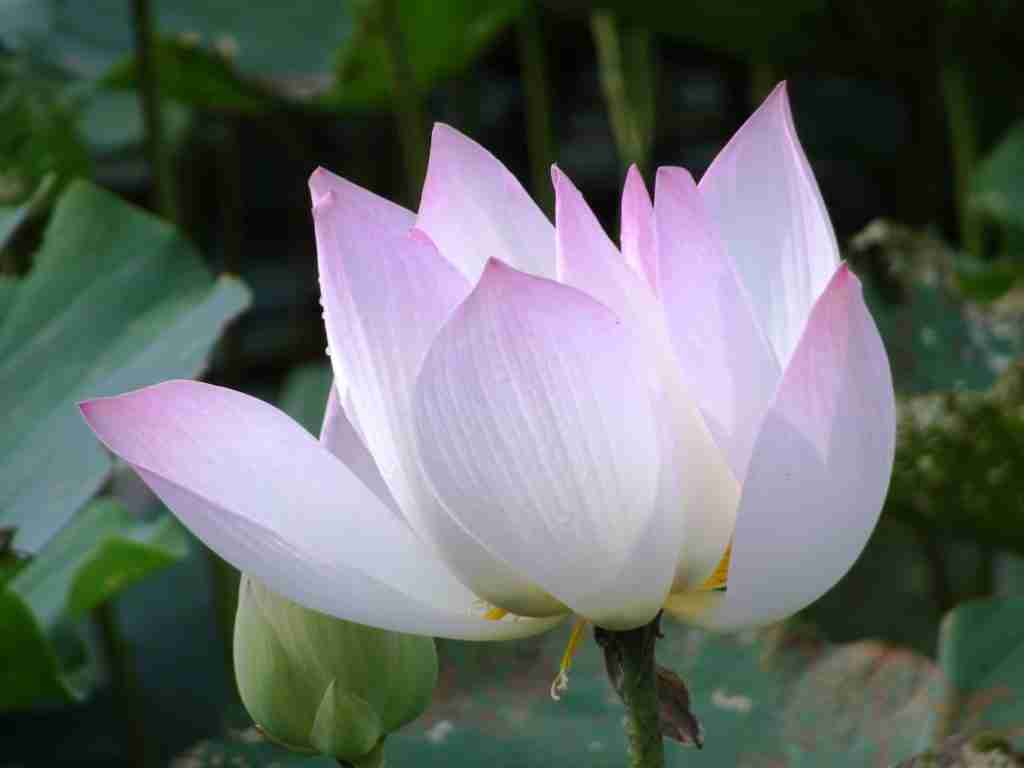
This page contains affiliate links, which means I may make a small commission if you make a purchase through those links. This does not cost you any extra and helps to keep this website running. Thank you for your support!
Where is Battambang located?
Battambang is in the northwest of Cambodia, on the overland route from Thailand to the capital Phnom Penh. The city’s location is important for trade and it’s also a convenient stopover for travellers.
Battambang in Cambodia is just a few hundred kilometres from the Thai border and less than 200km from the majestic temples of Angkor Wat, one of the largest religious monuments in the world and one of the main attractions for visitors in Southeast Asia.
TIP: If you don’t have time to stay overnight you can visit Battambang in Cambodia on a full-day tour from Siem Reap. On this tour, you’ll see the elegant French colonial architecture, visit ornate Khmer temples and ride the Bamboo Train through the countryside.
Is Battambang safe to visit?
Battambang is generally safe and friendly for women travelling alone and I had an amazing time travelling solo in Cambodia just taking the usual safety precautions.
How many days do you need in Battambang?
It’s worth spending at least 2 days in Battambang so that you can explore the city and spend some time visiting the temples and the rural villages in the area. You’ll see a different side of Cambodia and experience life in a more rural setting.
I was excited to see a group of monks, barefoot and dressed in saffron robes collecting alms on the streets. This is an everyday occurrence in Battambang Cambodia. The local community supports the monks and people donate food and money whenever they are asked.
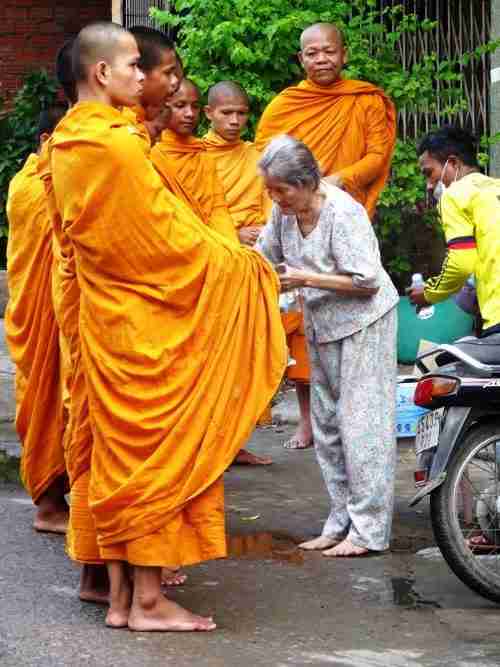

About Battambang in Cambodia
Battambang (pronounced Battam-BONG) was founded in the 11th century by the Khmer Empire. It became an important trading post in the northwest of the country in the 18th century and is one of Cambodia’s largest cities. Battambang Province was ruled by Thailand during the 19th century and in the early 20th century was ceded to the French and became part of Indochina.
The brutal Khmer Rouge regime left its mark on Battambang in Cambodia. The Killing Cave at Phnom Sampeau is a tragic reminder of the devastating Civil War that tore the country apart from 1967 to 1975. Battambang remained on the front line of the fight against the Khmer Rouge until 1996, and it’s only in recent years that tourists have returned to the city.
Battambang in Cambodia is a lovely place to visit. The well-preserved French colonial architecture of the Old Town brings charm and grace to the city. Battambang sits on the banks of the Sangkar River surrounded by peaceful rice fields and a picturesque rural landscape.
On a tuk-tuk tour outside the city, you can see some of the local industries, sample the food and visit the beautiful Ek Phnom Temple. At Phnom Banan, there are ancient Khmer ruins to explore and sweeping views of the countryside.
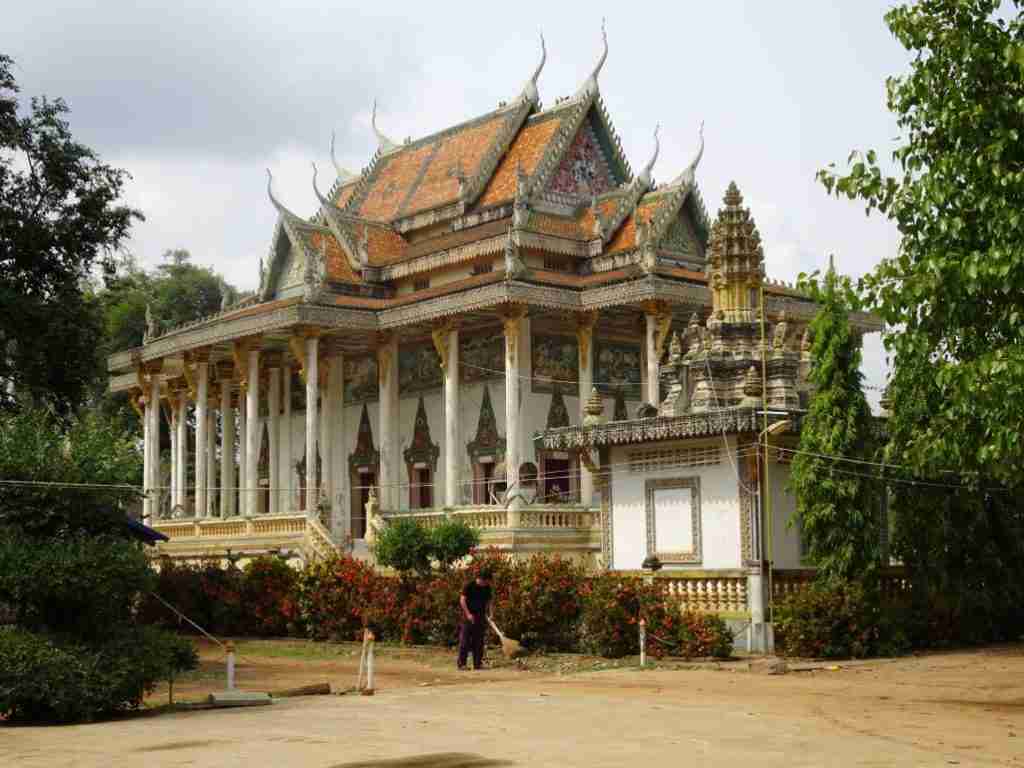
Things to do in Battambang Cambodia
Take a Tuk tuk tour around Battambang
A tuk-tuk tour of the villages is one of many fun things to do in Battambang and it’s a great way to get around the city and see the sights. My tuk-tuk drivers were Kim from Kim Tours and his brother Nani who took me out into the countryside to see some of the main attractions around Battambang in Cambodia.
Visit Gardens & Lilypond
First, we went to a beautiful garden with lush green lawns and a huge lily pond. It’s a favourite photo spot for the locals, especially popular for weddings.
Ek Phnom Temple
One of the best things to do in Battambang is just outside the city. The ornate Ek Phnom Temple with its striking Khmer architecture and large Buddha statue is well worth seeing. Next to the new Pagoda are the ruins of an 11th-century temple. A visit to Ek Phnom is a fascinating blend of old and new and it’s fun to explore the ancient temple ruins and wander through the lovely grounds of the traditional Khmer temple.
TIP: Book a Battambang Temple Tour in advance when you visit Battambang. See Wat Ek Phnom and the 11th-century ruins of Wat Banan with sweeping views from the top of the mountain.
Visit the villages around Battambang
In the villages around Battambang, there are a number of different cottage industries and it’s interesting to watch local people making rice wine, dried banana strips, cooking sweet sticky rice and making rice paper wrappers for spring rolls. We also stopped at a smelly workroom where they make fish paste in huge vats. We were able to try and buy some delicious local produce.
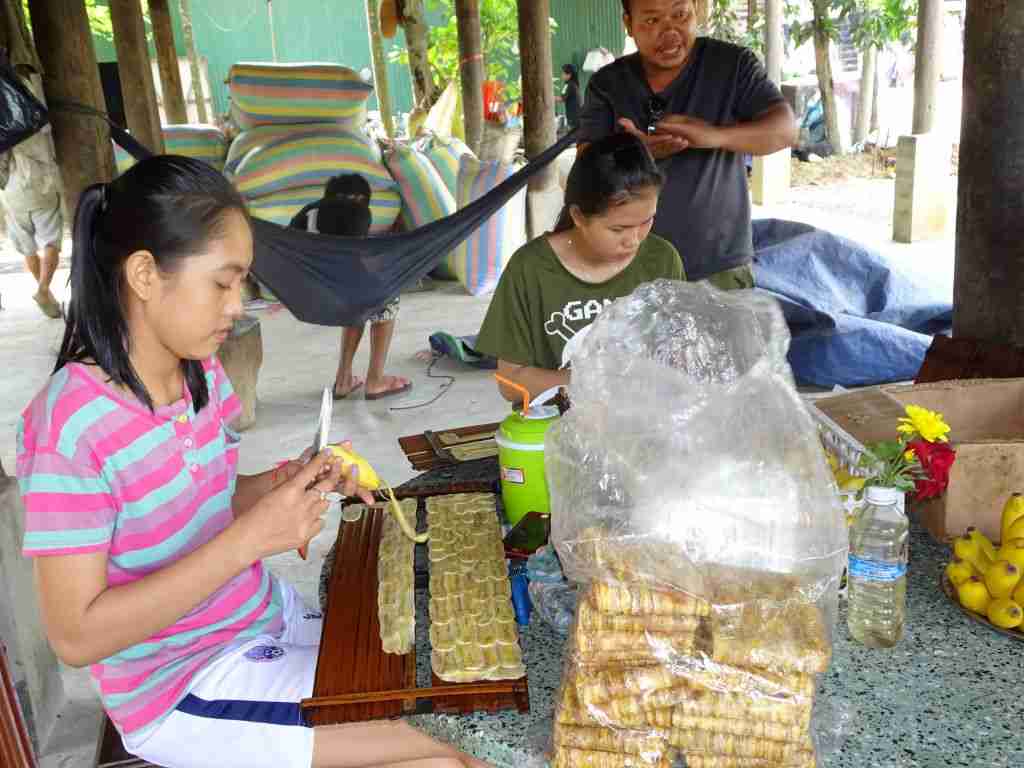
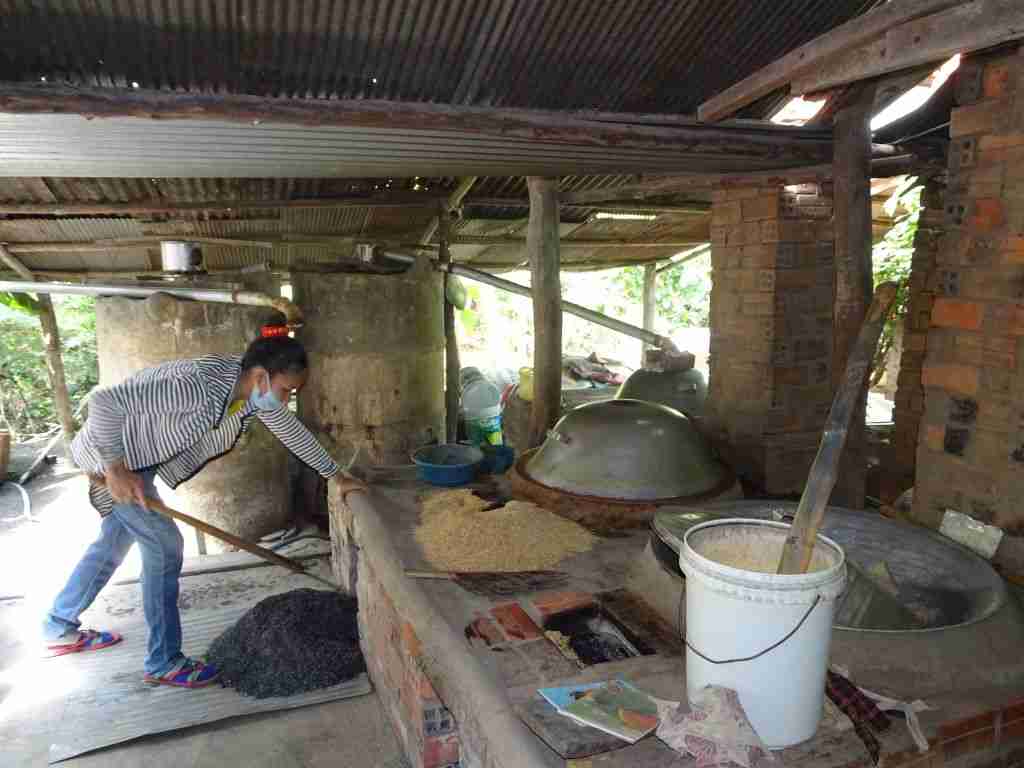
Phnom Sampeau Killing Cave
Later in the afternoon, we went to Phnom Sampeau to see Wat Phnom Sampov and the war memorial at the Killing Cave. Of all the things to do in Battambang, this was the most important and educational. It was here that the Khmer Rouge executed thousands of people during the Cambodian Civil War.
The Killing Cave can be found at the top of Phnom Sampeau. To reach the cave there’s a steep staircase with 700 steps through the jungle to Wat Phnom Sampov, the temple at the top of the hill. There are lots of monkeys at Phnom Sampeau and you’re likely to see some as you climb the stairs.
After enjoying the expansive view and escaping from some monkeys who were a bit territorial it was just a short walk to the Killing Cave. The war memorial is a distressing place to visit but essential to understanding the recent history of Cambodia and the tragedy of the Civil War.
Inside the Killing Cave, there’s a Buddhist shrine with a reclining Buddha and a glass case that holds the skulls of thousands of people who were killed here during the Civil War. Locals estimate that 10,000 people died here, bludgeoned to death by the Khmer Rouge. Their bodies were thrown into the cave. Outside the cave, there are life-size sculptures and statues that illustrate the atrocities committed there.
My guide Nani was from a family who had lost loved ones in the war. In fact, his parents met in a refugee camp as both had lost their partners. It was moving to hear his story and to understand how deeply the local people have been affected by the tragedy of the Cambodian Civil War.
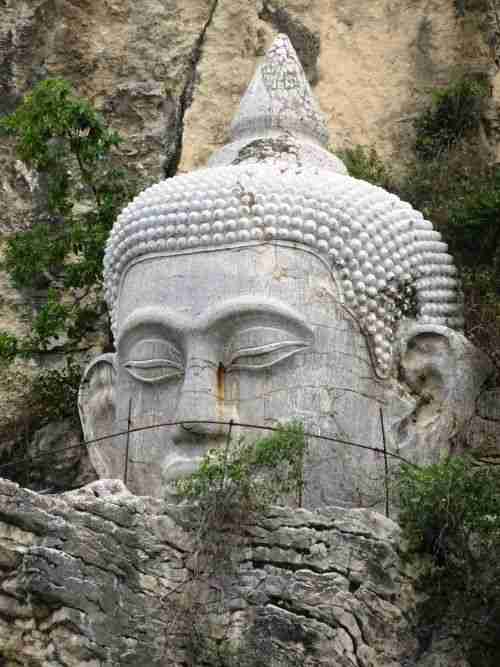
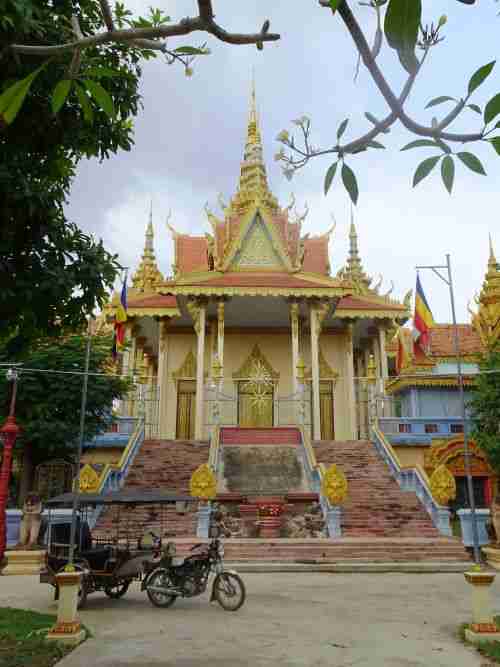
Watch Bats leaving the cave at sunset
After returning to the base of Phnom Sampeau (via the road rather than the stairs), I joined the throng waiting for a colony of around 15 million small bats to leave the cave to feed. The bats live in the caves and wait for the sun to go down before they fly out under the cover of darkness.
On the return trip to Battambang, you can see the cauldron of bats flying over the rice fields looking for mosquitos and other insects to feed on.
The Battambang Circus
One of the best things to do in Battambang is to treat yourself to a night out at the circus. Battambang in Cambodia is the home of the Phare Ponleu Selpak Circus, a non-governmental organisation that helps disadvantaged young people learn performance and circus skills and gives them an opportunity to develop their talent in the creative arts. The young performers learn from professional acrobats, trapeze and tightrope walkers amongst others. The Phare Circus performances are exciting and dramatic.
A night out at the circus is lots of fun and it also benefits the local community. Performances include traditional Cambodian music and dance and take place in Battambang on Thursday and Sunday evenings 7 – 8 PM.
The Phare Circus also gives performances in Siem Reap and you can book your tickets in advance for Siem Reap
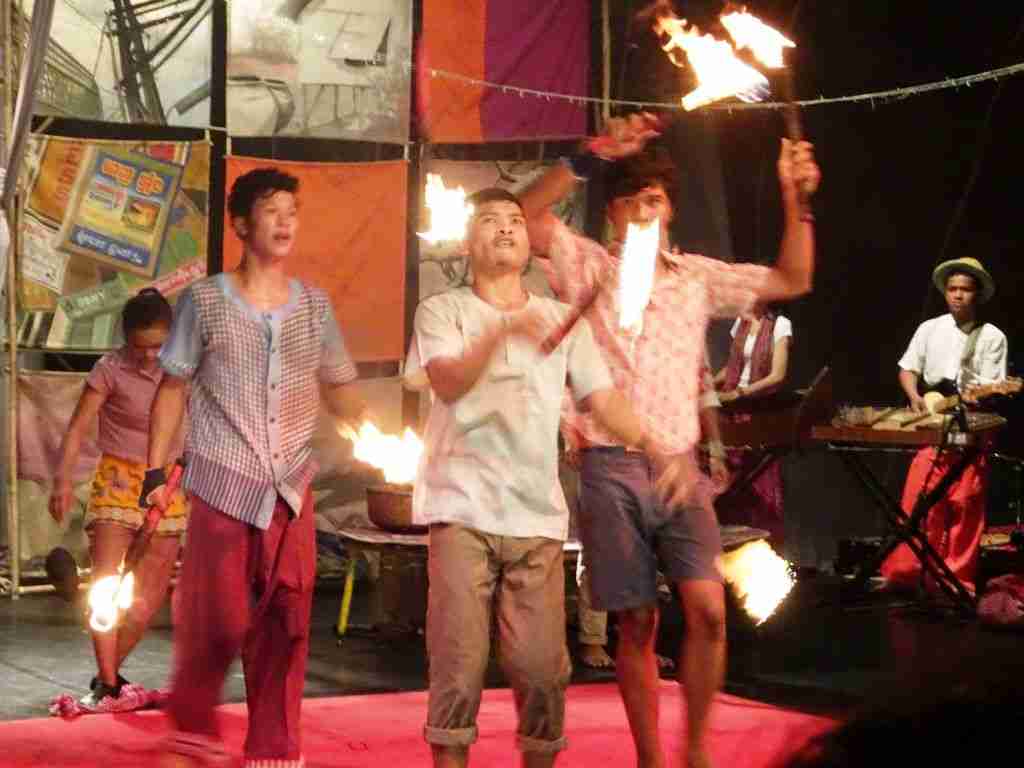
More things to do in Battambang
The Bamboo Train
Riding the Bamboo Train is one of the most popular things to do in Battambang. The Bamboo Train or Norry is an improvised rail service and a popular tourist attraction on the outskirts of Battambang. The Train consists of a flat bamboo platform that runs on a rail track for 7 kilometres and can reach speeds of up to 50 km per hour.
The rail network was originally built by the French and the Bamboo Train stopped operating during the Khmer Rouge Regime. It was reopened for tourists near Wat Banan in 2018. Although many people really enjoy a ride on the Bamboo Train there are reports of local drivers demanding tips from tourists and some say it has become a tourist trap.
Wat Banan Temple
Exploring the ancient temple ruins at Wat Banan is one of many fun things to do in Battambang. The ruins of Wat Banan Temple date back to the 11th century and are located around 25 kilometres to the south of the city. There are more than 350 stone steps to climb to the temple and you can enjoy beautiful views of the surrounding countryside from the top of the mountain near Battambang in Cambodia.
On the Battambang Temple Tour, you’ll visit Wat Banan, enjoy panoramic river views, and discover the ruins of Wat Ek Phnom.
Night Markets
If you’re looking for more fun things to do in Battambang, head to the Night Markets to try some local street food. There are two Night Markets in Battambang and they both have a great selection of regional Khmer food featuring noodles and rice.
The new market, located near the Sangkar River has a selection of outdoor restaurants on the river bank. The older market is close to Psar Nath. As well as street food you can buy souvenirs, clothes and jewellery but make sure you bargain to get the best price.

How to get there
The quickest way to travel around Cambodia is by bus. And travel by river is a great way to see more of the country and to experience a different, slower way of life when you visit Cambodia.
There’s a direct train to the capital Phnom Penh and the trip takes about 8 hours.
Buses and ferries in Cambodia can be booked online with 12Go Asia
Travel by Bus
Buses and minibuses are popular ways to travel to Battambang in Cambodia.
A Bus from Phnom Penh to Battambang takes 6 hours. I took an air-conditioned minibus and found it cramped and cold so rug up for the journey.
The bus from Siem Reap to Battambang takes around 4 hours
The Bus trip from Bangkok to Battambang takes around 8 hours.
Travel by Riverboat
By far the most interesting way to travel to Battambang in Cambodia is by riverboat. For me, travelling by river from Siem Reap to Battambang was an unforgettable experience. The journey was long, around 7 hours, and the weather was very hot but it was a wonderful opportunity to see rural life on the river.
The warmth and friendliness of the local people shone through and were quite heartwarming. The welcoming waves and calls of people going about their lives were truly memorable. As the riverboat passed by, excited children rushed from their floating classroom to shout and wave.
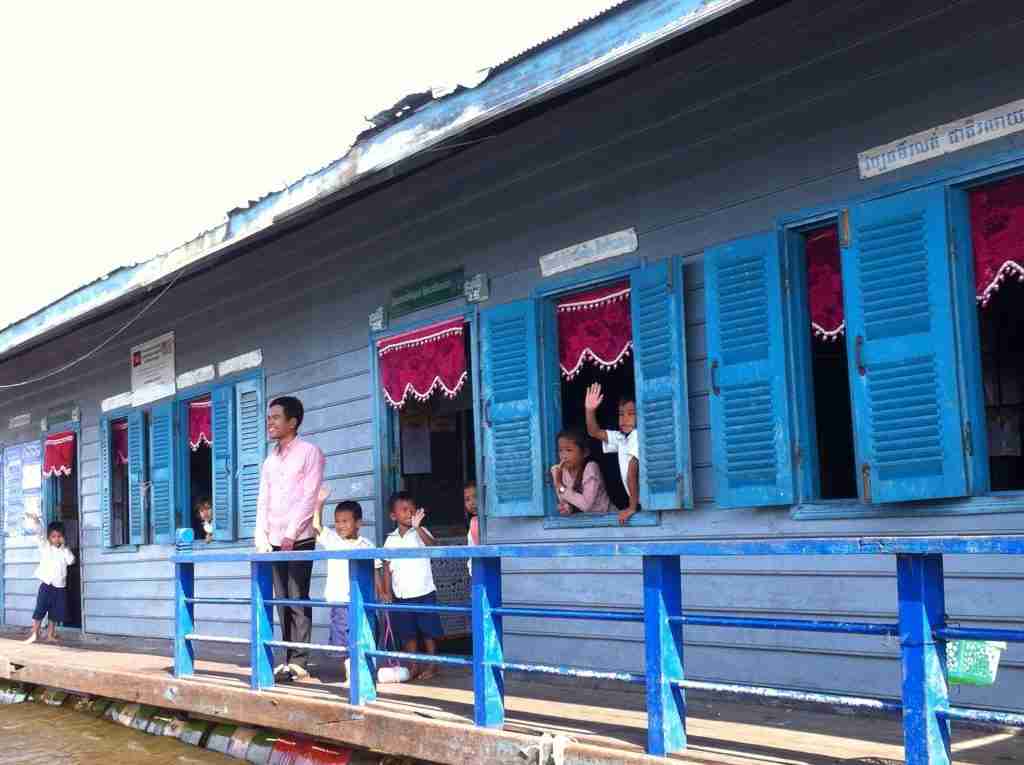
Many people recommend taking the bus from Siem Reap as the journey is shorter taking only 4 hours compared to 7 hours on the riverboat, but I was happy to sacrifice some comfort for the experience. I think riding on the ferry and seeing life on the river is one of the best things to do in Battambang because you get a glimpse of everyday life in poorer parts of the country that you don’t see in the main tourist areas.
When the riverboat arrived in Battambang, I was met at the ferry wharf by a tuk-tuk driver sent by the Seng Hout Hotel. At the hotel, I was able to arrange a local tuk-tuk tour to Ek Phnom Temple and the villages for the next day.
Where to stay in Battambang
Budget – The Lucky Hostel & Guest House is good value for money and gets great reviews for its central location.
Mid-Range: I stayed at the Seng Hout Hotel. It has a convenient central location near the river and the Night Market. I enjoyed the pool and the friendly staff. Reception at the Seng Hout Hotel arranged all my tours and bus tickets and a free transfer from the riverboat to the hotel. My cheap room was very old & the bathroom was mouldy so I suggest booking a more expensive room in the newer wing.
Luxury: For a more luxurious stay in Battambang try the Battambang Resort located 10 minutes out of town.
And Maisons Wat Kor also gets excellent reviews.
What is the best month to go to Cambodia?
Between November and May, Cambodia has warm weather and low rainfall and it’s a good time to visit. Cambodia has hot humid weather all year because of its location near the equator but temperatures are slightly cooler from November to February. I was there in January during the peak tourist season and enjoyed the hot, sunny weather throughout my stay.
Where to go after Battambang?
After visiting Battambang you can head to the Cambodian capital, Phom Penh, to Siem Reap and the majestic Angkor Wat Temples or to the Thai border and on to Bangkok.
Travel essentials
Don’t forget your trusted Lonely Planet Guide. I rarely travel without one and can recommend the Cambodia guide. It will help you plan an amazing trip and always comes in handy when you’re away.
Travel insurance is another travel essential. I always use Travel Insurance for my overseas travel, especially if I’m travelling solo. I can relax knowing I’m covered if something unexpected happens while I’m away.
Final Thoughts
I really enjoyed visiting Battambang in Cambodia with its elegant French colonial architecture and rich history. Arriving in Battambang on the riverboat was a highlight and I loved the ancient Khmer temples. I had a fun night out at the Phare Circus and was glad I saw the Killing Caves at Phnom Sampeau, a necessary and shocking reminder of the tragedy of the Cambodian Civil War. There is no shortage of great things to do in Battambang and I would recommend making time to visit for a day or two.
You might also enjoy
Vibrant Phnom Penh in Cambodia – 8+ Highlights
Best 10 Days in Cambodia – Highlights and Tips
Cambodia Travel: Why Angkor Wat is So Special
Solo Travel in Cambodia – What You Need to Know
Beautiful Vietnam in 3 weeks from Top to Toe
How to Visit Stunning Halong Bay in Vietnam
Is Lempuyang Temple Worth visiting in Bali?
21 Beautiful Temples of Indonesia
The 10 Thousand Buddhas Monastery – A Hidden Gem
The Big Buddha in Hong Kong – A Stunning Day Trip
Pin It! If you enjoyed this article why not save it for later?
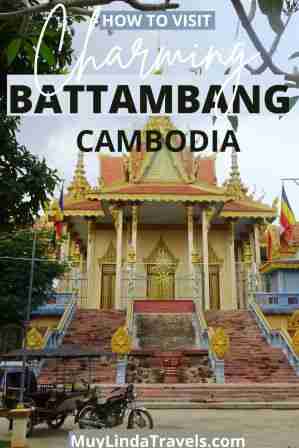

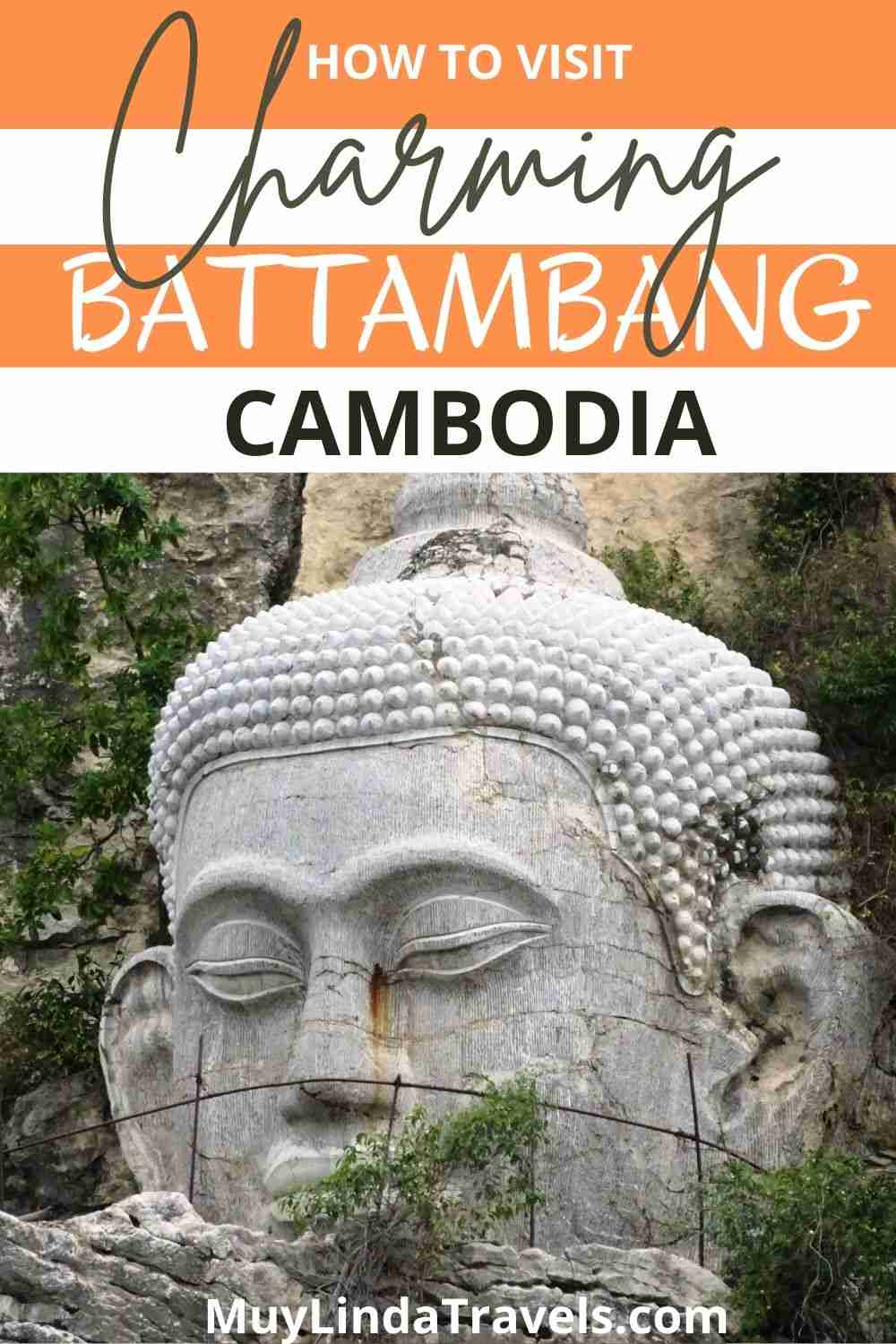
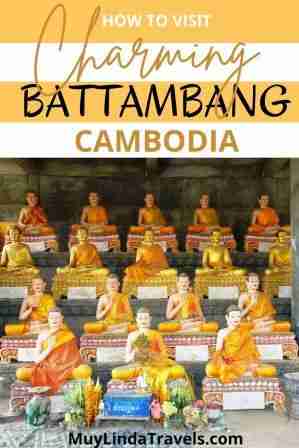


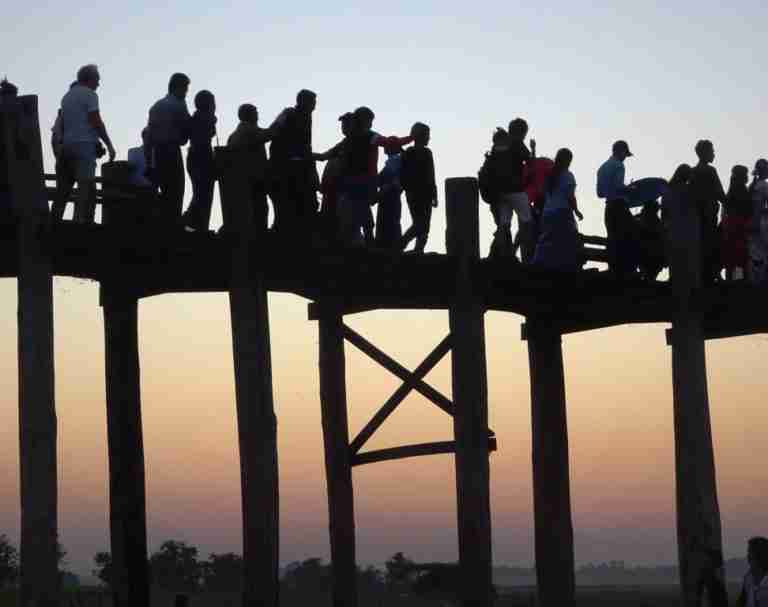
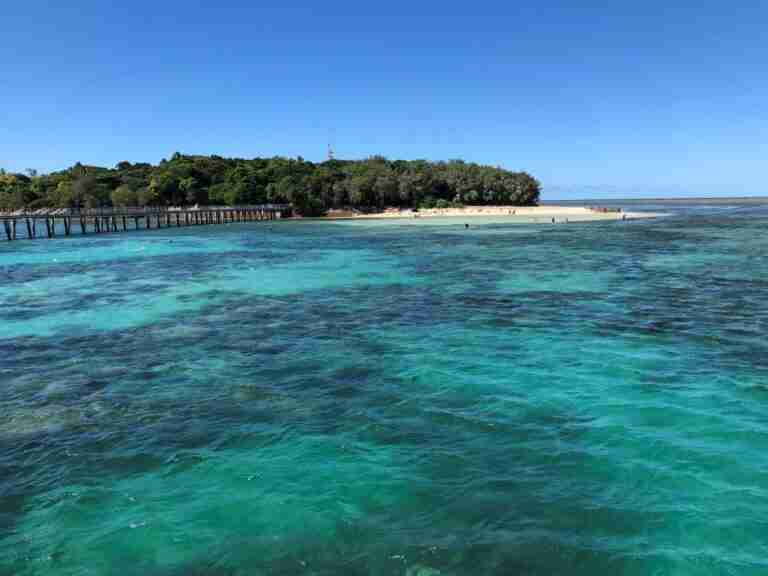

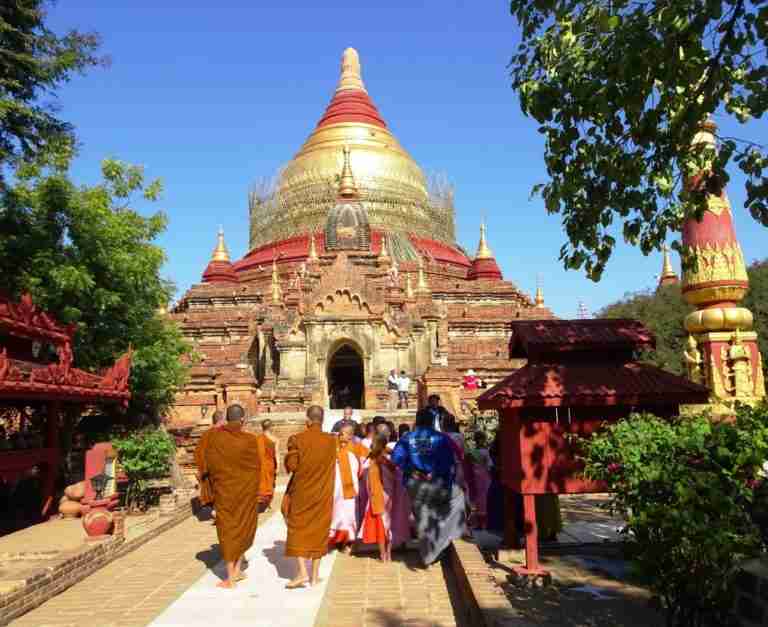

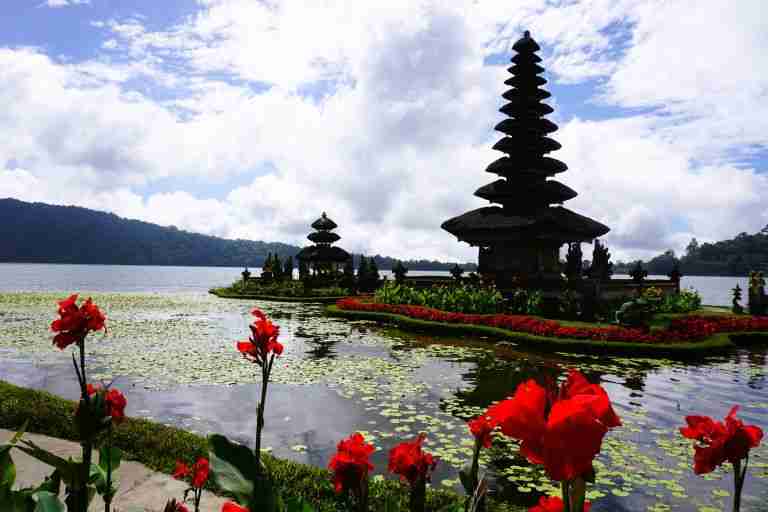
The bamboo train sounds quite appealing. I hope the tourist scams do not affect the joyful ride.
Cambodia is one of my favourite Asian countries. I have been to Cambodia twice but never visited Battambang. Now there’s a reason to go back to Cambodia.
Cambodia sounds so interesting, thanks for sharing!
What a great guide, very complete with great tips. I LOVE Cambodia, and I want to go back and continue exploring, thanks for sharing about Battambang as it is now added to my list for my next trip.
I have yet to make it to Cambodia but this rural enclave sounds authentic and full of cultural insight. Just the type of place I would go.
What a fascinating destination – one I would absolutely love to explore.
I love the temples and architecture of Cambodia and Indonesia…what a fascinating place to visit..I would love to get there one day
I’m thinking to go to Cambodia at the end of the year and this place is so high on my list! I have read about it before, but I still find a lot of new and useful information in your article! So I will save it for the time once I actually get to visit. Fingers crossed!
Remote or rural Cambodia is the best isn’t it? We visited about 20 years ago but may head back next year so I’ve saved this for somewhere local to visit. 🙂
I have never been to Cambodia but your detailed itinerary makes me want to visit! Your photos are wonderful.
Fantastic post. It is such a contrast to see the beautiful temples, night markets and friendly people…then to learn about the killing caves. It sounds like a fantastic (if at times sobering) area to visit.
I hope to go to Cambodia in the future! Thanks for writing this really helpful post.
I can not wait to get to visit Cambodia! Now I have added Battambang to my list. Great guide!
I would love to visit Cambodia, when I do, Ill definitely have to add Battambang to my itinerary! Thanks for sharing!
I’ve never heard of battambang before but it looks awesome! What a unique place to visit. I’d love to visit Cambodia.
Would love to visit Cambodia and this is a great guide! Tons of tips to refer to.
Cambodia is so unique and different than any place I’ve experienced – I would love the tuk tuk exploration or the riverboat! Everything is so colorful too. Thanks for sharing this beautiful destination with us!
I love the idea of visiting Battambang on a day trip from Siem Reap. I travel to Siem Reap regularly on business trips and often have a free day to explore the capital’s surroundings. Next time I’ll surely check out Battambang and explore all the things to do here as per your suggestions 🙂
I would love to visit this part of the world. There’s so much history and culture to learn about. Thanks for sharing these tips!
I went to Cambodia a few years ago but missed Battambang. You’ve made me want to return. I remember visiting the Killing Fields outside Phnom Penh & it was a terrifying & sobering day. I agree with you that it’s something you have to do when visiting Cambodia to understand the history of the country. Heartbreaking.
Cambodia has been on my list for so long and this has convinced me even more that I need to visit! Love your photos
I love thinking back to my time in Cambodia. What a unique country! Haven’t been to Battambang yet, so I’ll definitely add it so my list for next time. Thanks for this great guide!